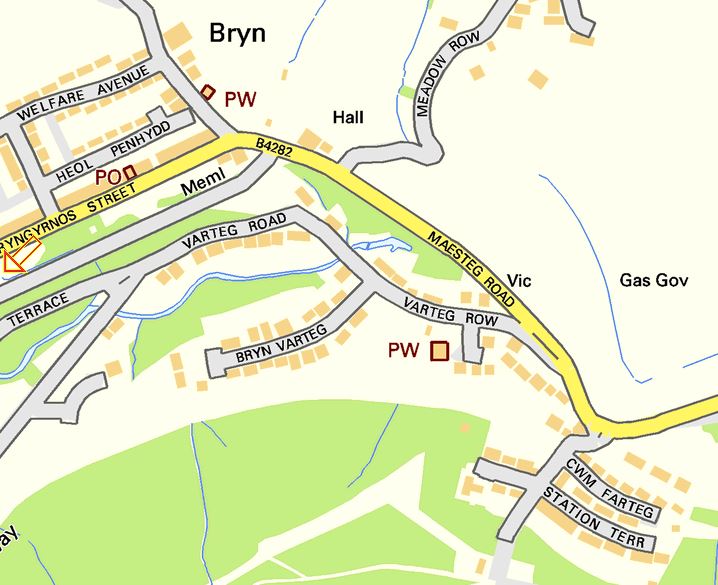The publisher's word-count restrictions for the manuscript of Real Port Talbot imposed a limit on how much I could write but I chose to include all of the surrounding villages and write a little on each rather than just focus on the central hub of Aberafan and Port Talbot.
In the small section for the village of Bryn I found space for the remains of one of its brickworks, listed with Cadw as rare examples of kilns associated with 19th century brickworks, the collieries and the story of the champion boxing miner Billy Beynon, and for the Beast of Bryn, the challenging annual alpine trail run that attracts runners from all across the world.
I didn't find the space for the old school whose high stone wall is still intact along Varteg Row and whose school gate stands on a field of rubble like a sentry.
In the small section for the village of Bryn I found space for the remains of one of its brickworks, listed with Cadw as rare examples of kilns associated with 19th century brickworks, the collieries and the story of the champion boxing miner Billy Beynon, and for the Beast of Bryn, the challenging annual alpine trail run that attracts runners from all across the world.
I didn't find the space for the old school whose high stone wall is still intact along Varteg Row and whose school gate stands on a field of rubble like a sentry.
Graham Rowland, organiser of the Beast of Bryn, remembers attending school here and on rainy days being moved around the class to avoid being soaked by the leaking roof.
Neither did I have the space for the adjacent St Tydfil's Church, built in 1902 with £5,500 donated by Emily Talbot. The original parsonage, opposite, and the church hall, built in 1915 and now used as a church, have both survived but all that remains of St Tydfil's is the foundation stone laid by Miss Talbot in 1900. The original church was sadly demolished in the 1990s due to a waning congregation.
Neither did I have the space for the adjacent St Tydfil's Church, built in 1902 with £5,500 donated by Emily Talbot. The original parsonage, opposite, and the church hall, built in 1915 and now used as a church, have both survived but all that remains of St Tydfil's is the foundation stone laid by Miss Talbot in 1900. The original church was sadly demolished in the 1990s due to a waning congregation.
Where Varteg Row meets Maesteg Road there's a rough looking rendered building on the right with the St John's Ambulance crest above the door. But this was once the Miners' Rescue Centre and Graham Rowland confirmed there is still a marble slab inside where the bodies of lost miners were laid and washed and, I imagine, prayed over too.

The hillside opposite is now a nature reserve but you can still see a colliery ventilation shaft pushing through the earth as a reminder of the risks and dangers miners faced. One of those tragic events was reported by The Cambrian Daily Leader on 6th April 1918: two young brothers from Cwmafan killed by a roof fall.
Listen carefully now: can you hear the faint voices of lost men, the sobs of mothers and wives? Turn back on yourself: church bells and the laughter and ruckus of children playing? Sometimes it feels as if we are walking through history.
Sources:
Bryn Residents' Action Group
And many thanks to Graham Rowland. for his company, memories and stories.
Listen carefully now: can you hear the faint voices of lost men, the sobs of mothers and wives? Turn back on yourself: church bells and the laughter and ruckus of children playing? Sometimes it feels as if we are walking through history.
Sources:
Bryn Residents' Action Group
And many thanks to Graham Rowland. for his company, memories and stories.






 RSS Feed
RSS Feed